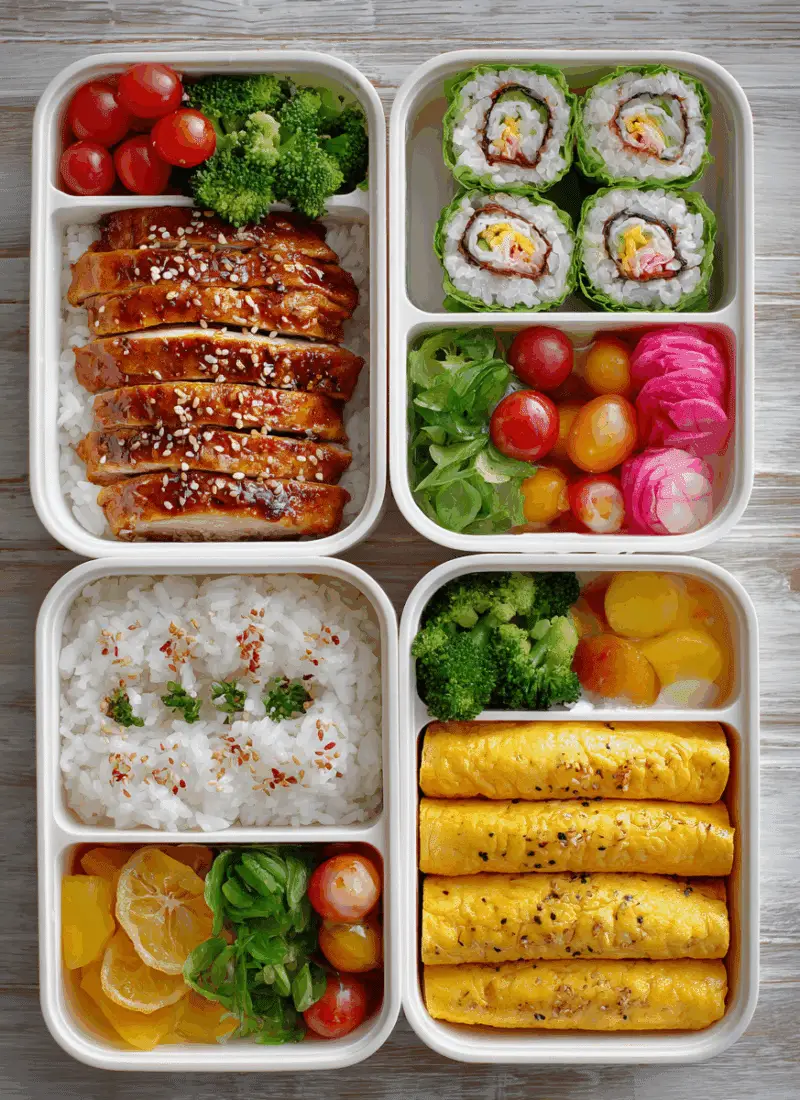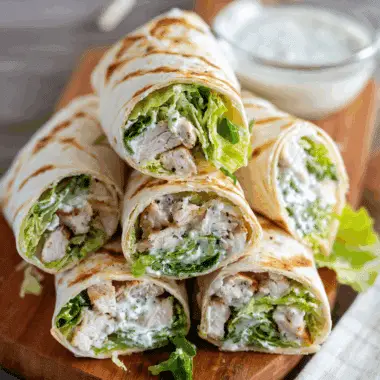Bento lunch boxes are a creative, nutritious, and convenient way to pack meals for school, work, or on-the-go eating. Originating from Japan, bentos are traditionally packed with a variety of bite-sized foods, offering a colorful and well-balanced selection of proteins, grains, and vegetables. This recipe offers a classic, prep-ahead bento lunch that includes teriyaki chicken, steamed rice, tamagoyaki (Japanese rolled omelet), blanched broccoli, cherry tomatoes, and fruit slices.
FULL RECIPE
Ingredients
1.For Teriyaki Chicken:
- 2 boneless skinless chicken thighs
- 2 tablespoons soy sauce
- 1 tablespoon mirin
- 1 tablespoon sake (or water if unavailable)
- 1 teaspoon sugar
- 1 teaspoon sesame oil
2.For Tamagoyaki (Japanese Omelet):
- 2 large eggs
- 1 teaspoon sugar
- 1/2 teaspoon soy sauce
- 1 teaspoon dashi stock (or water with a pinch of salt)
- Neutral oil, for cooking
3.For Rice and Sides:
- 1 cup cooked Japanese short-grain rice
- 1 teaspoon sesame seeds (optional)
- 1/2 cup broccoli florets
- 1/4 cup cherry tomatoes, halved
- Fruit slices (e.g., apple or kiwi)
- Pickled radish (optional)
Directions
- Prepare the Teriyaki Chicken:
In a small bowl, mix soy sauce, mirin, sake, sugar, and sesame oil. Heat a pan over medium heat and cook the chicken thighs skin side down until browned. Flip and cook until done. Pour in the sauce and simmer until thickened. Let cool slightly, then slice into strips. - Make the Tamagoyaki:
Beat the eggs with sugar, soy sauce, and dashi. Lightly oil a tamagoyaki pan (or small nonstick skillet) over low-medium heat. Pour a thin layer of egg mixture, tilt to spread, and when it’s nearly set, roll it to one side. Repeat with remaining egg, lifting the previous roll to let raw egg flow underneath. Let cool and slice into 3-4 pieces. - Blanch the Broccoli:
Boil a small pot of water. Add broccoli and blanch for 1–2 minutes until bright green and slightly tender. Rinse under cold water and drain well. - Pack the Bento Box:
Start by filling one section of the box with rice and sprinkle with sesame seeds. Add teriyaki chicken strips beside the rice. Place tamagoyaki next to the chicken. Fill the remaining sections with broccoli florets, cherry tomatoes, and fruit slices. Add pickled radish if desired. - Chill and Store:
Close the bento box tightly. Store in the refrigerator for up to 24 hours. Reheat if desired, or serve cold/room temperature.
Nutrition Facts
- Calories: 480 kcal
- Protein: 29g
- Carbohydrates: 45g
- Sugars: 8g
- Dietary Fiber: 4g
- Total Fat: 20g
- Saturated Fat: 4g
- Cholesterol: 195mg
- Sodium: 900mg
- Vitamin C: 45% DV
- Iron: 15% DV
- Calcium: 8% DV
Cultural Significance of Bento Boxes
Bento boxes are a cornerstone of Japanese culinary culture, known not only for their practicality but also for their aesthetic appeal and symbolic meanings. Traditionally, a bento reflects the Japanese value of “balance” — combining taste, nutrition, and visual harmony in one container. Each section of the box is thoughtfully filled with different food types to maintain this balance, often incorporating the five colors (red, green, yellow, white, and black) and five flavors (sweet, salty, sour, bitter, and umami). While bentos have evolved globally, the fundamental principles remain the same, turning even a simple lunch into a mindful eating experience.
Health Benefits of a Well-Balanced Bento
A traditional bento box is inherently healthy, often offering a balanced mix of lean protein, complex carbohydrates, and colorful vegetables. This balance helps regulate blood sugar levels, sustain energy throughout the day, and avoid the post-lunch crash often caused by heavier meals. For example, teriyaki chicken provides quality protein, steamed rice offers a clean source of carbs, and the inclusion of vegetables like broccoli and cherry tomatoes supplies essential vitamins and fiber. Portion control is also naturally built into the design of the bento, encouraging moderate, satisfying meals without overeating.
Make-Ahead Convenience and Meal Prep Appeal
One of the standout advantages of bento boxes is their compatibility with meal prep routines. Components like tamagoyaki, cooked rice, and teriyaki chicken can be made in advance and refrigerated or even frozen in portions for later use. This makes it easy to assemble a complete meal on busy mornings without compromising nutrition or flavor. For people managing hectic schedules or trying to avoid takeout, bento boxes are a fantastic solution that combines homemade quality with the convenience of fast food.
Creative Presentation and Visual Appeal
Bento-making is often considered a form of edible art in Japan, where the visual aspect of food is as important as taste. Bento boxes are often decorated with cute or elaborate arrangements known as “kyaraben” (character bento), especially for children. Even in simpler adult versions, attention to color, texture, and symmetry makes the meal more enjoyable and appetizing. A neat presentation can elevate everyday ingredients into something special, encouraging mindful eating and appreciation for the meal.
Endless Ingredient Variations
Bento boxes are incredibly versatile and can be customized based on dietary needs, preferences, or seasonal ingredients. For example, vegetarians might swap the chicken for tofu teriyaki, while pescatarians could include grilled salmon or shrimp. Brown rice or quinoa can replace white rice for added fiber, and vegetable selections can range from edamame to roasted sweet potatoes or sautéed spinach. This flexibility makes bentos suitable for virtually any diet, including low-carb, keto, gluten-free, or dairy-free.
Portability and Eco-Friendly Design
Bento boxes are ideal for those who need portable meals without relying on disposable packaging. Most modern bento containers are reusable, compact, and leak-proof, making them excellent for school lunches, office meals, or picnics. The multiple compartments minimize the need for extra containers or plastic wrap, aligning with eco-conscious living. Investing in a quality bento box also reduces food waste, as leftovers and odds-and-ends from the fridge can easily be repurposed into a satisfying meal.
Kid-Friendly and Family-Oriented Options
Bento boxes are especially popular with children because they make eating fun. Bite-sized portions, bright colors, and playful shapes can entice even picky eaters to try new foods. Parents often include a mix of familiar favorites and nutrient-rich options to gradually expand their children’s palates. Bento-style lunches are also easy to scale up or down, making them practical for the whole family. Whether for toddlers or teens, bento boxes can be tailored to suit individual tastes while maintaining a nutritious foundation.
Complementary Dips and Sauces
While the base components of a bento box are flavorful on their own, including small servings of sauces or dips can enhance the experience. A small container of soy sauce, spicy mayo, or sesame dressing adds variety without overwhelming the palate. Tamagoyaki might be paired with a dash of soy or a light ponzu sauce, while steamed veggies can benefit from a sprinkle of furikake seasoning. These additions provide bursts of flavor and encourage dipping, which adds a layer of interactivity to the meal.
Recommended Pairings and Beverage Ideas
Bento boxes pair well with light, refreshing drinks that don’t overpower the meal’s flavors. Traditional pairings might include green tea, barley tea (mugicha), or a mild miso soup served on the side. For modern or Western-inspired takes, sparkling water with a splash of citrus or a low-sugar iced tea works beautifully. A small cup of fruit yogurt or a piece of dark chocolate can also round out the lunch as a wholesome dessert. The goal is to complement the bento’s balanced nature without adding unnecessary calories or heaviness.
Proper Storage and Food Safety Tips
Because bento boxes are often prepared in advance and eaten later, proper food safety is crucial. All ingredients should be cooled to room temperature before sealing to prevent condensation and bacterial growth. Use ice packs or an insulated lunch bag if the bento won’t be refrigerated before eating. Moist or high-risk items like cooked meat and eggs should be consumed within 24 hours. For longer storage, consider freezing certain components separately and assembling fresh on the day of consumption.
Conclusion
Bento lunch boxes offer a delightful fusion of nutrition, creativity, and practicality. Whether you’re meal prepping for the week, packing a lunch for a child, or looking for a new way to enjoy homemade food, bentos provide a satisfying and aesthetically pleasing solution. With limitless variations, minimal waste, and a focus on balance and portion control, they can fit into nearly every lifestyle.








